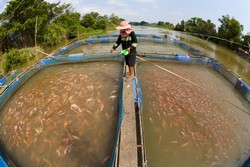Information systems for aquaculture
Aquaculture farms often face problems that include ineffective information gathering and poor online water quality monitoring. The China-EU Center for Information & Communication Technologies in Agriculture (CICTA) had previously designed a suitable remote monitoring system addressing such issues. The EU-funded SENSORFISH(opens in new window) (Intelligent sensor network and system technologies for fish farming) project further developed the CICTA system. The innovation combined smart sensor and communication technologies to manage aquaculture production. The consortium also fostered networking and collaboration among Canadian, Chinese, European and United States partners. Researchers first collected information useful to various stakeholders. The team queried 84 fish farmers from 16 Chinese provinces, and conducted an additional 16 on-the-spot interviews. The group thus determined the online monitoring and control needs of Chinese fish farmers. Subsequently, investigators explored advanced sensing principles and fabrication techniques for intelligent sensors. The group established sensor protocols, while also identifying new operating systems, storage schemes and other hardware. One such innovation was a new ROV sensor platform, used to measure 3D water quality in aquaculture areas, seas and channels. The ROV's data supports monitoring and decision-making. Researchers designed efficient smart monitoring strategies. Such strategies were used to estimate unknown rates and concentrations in the recirculation system, to illustrate the dynamics and to provide control. The team also developed advanced control strategies for safe, efficient and economical fish farming. An image analysis system was advanced that counts salmon eggs and determines whether juveniles have undergone smoltification. The innovation helps assess whether juveniles are ready for transfer to saltwater sea cages. The consortium also developed a sensor buoy that assesses water quality. The device was deployed at three Norwegian sites, and helped with daily farm management. SENSORFISH's new remote sensor technologies help to improve the management of aquaculture farming. Such ventures should thus become more efficient and productive.







